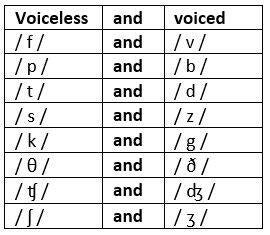Before we look at individual phonetic symbols for consonants and their corresponding sounds, it’s important to talk about voiced and voiceless sounds. It may sound surprising, but there are several consonants in English that do not use your vocal chords – in other words, they are whispered.
Let’s look at / f / and / v / for example. These two consonants are made in exactly the same way, in exactly the same place – with your top teeth placed lightly on your bottom lip. The only difference between the two sounds is that one uses your vocal chords and the other doesn’t.
Put the tips of your fingers lightly on your throat. Now say /fffffff/. Can you feel any vibration? Now say /vvvvv/. With the / v / sound, you should feel a vibration. This vibration is coming from your vocal chords (you’re making a voiced sound). With the / f / sound, there is no vibration because your vocal chords are not vibrating (here, you’re making a voiceless sound).
In fact, two thirds of English consonants are pairs of voiced and voiceless sounds, i.e. they’re made in the same way except one uses your vocal chords and the other doesn’t. Let’s look at them now. Don't worry if you don't recognise some of them yet, the table below is for reference and will make much more sense at the end of this blog series!

Try saying all of the pairs that you recognise. But beware! Don’t put an / ə / sound on the end of the consonants, because the / ə / is voiced and will therefore make all of the consonants sound like they’re voiced. In the same way, if you say words containing these consonants, you’ll also get a mix of voiced and voiceless sounds and you won’t be able to tell the difference between voiced and voiceless! I don’t know about you, but I find it amazing that our vocal chords turn on and off so quickly – many thousands of times per day!
You may wonder why I am telling you about voiced and voiceless consonants. There are two reasons: first of all, it’s a more interesting way of practising consonant sounds. Secondly, it makes you more aware that really you only have 16 mouth positions to learn, rather than thinking you have to learn all 24 of them separately.
Tomorrow, we’ll start looking at those phonetic symbols which don’t look like the English letters we’re used to seeing.
In the meantime, if you'd like more information about listening to, watching and practising phonetic symbols and their corresponding sounds, please click here.
Add comment
Comments